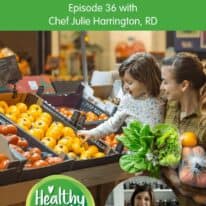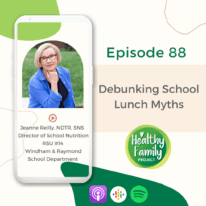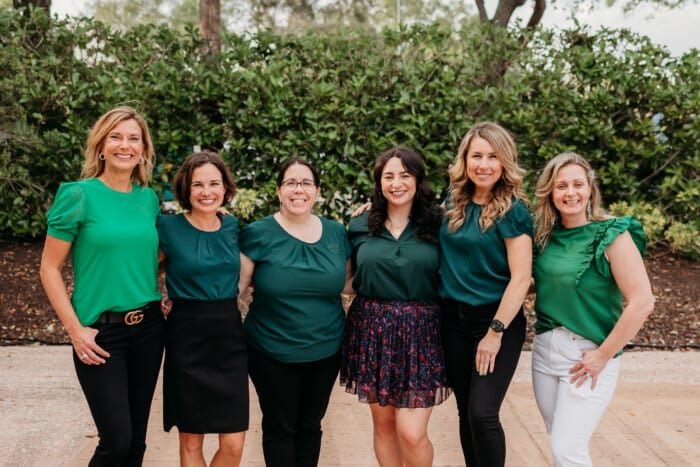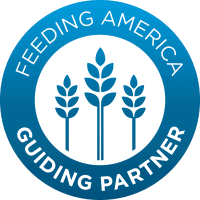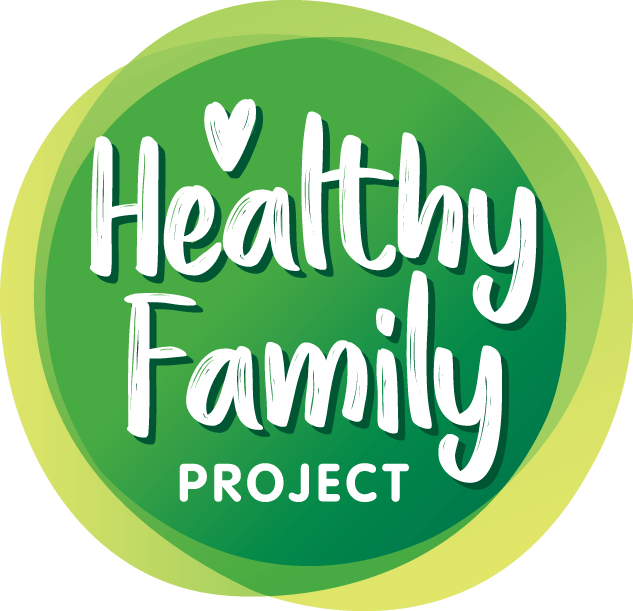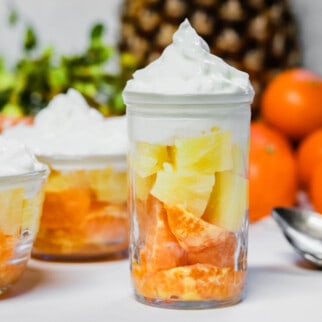Episode 36: Dietitian-Approved Healthy Grocery Shopping Tips
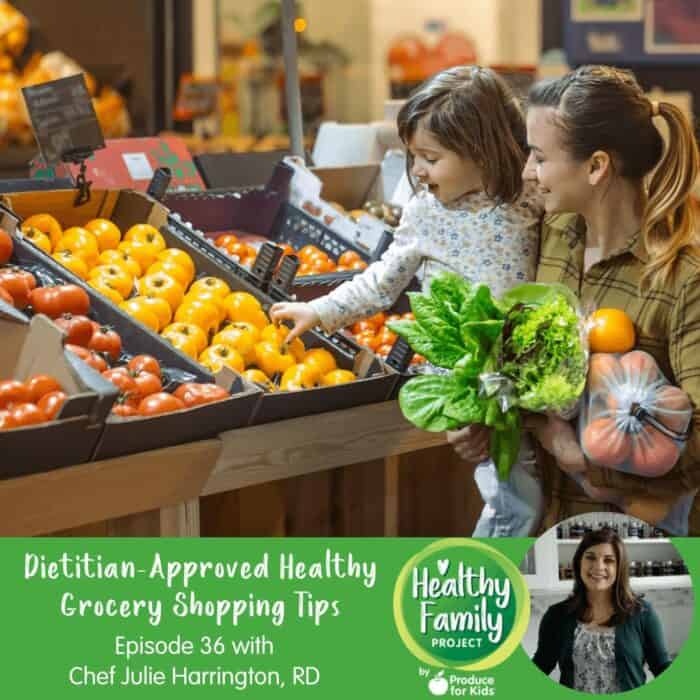
In this episode of Healthy Family Project, we talk to registered dietitian Julie Harrington of julieharringtonrd.com about how to make healthy choices at the grocery store that go beyond the perimeter of the store.
Julie believes that there is no one size fits all approach to nutrition and shares lots of great tips for finding healthy foods outside of the produce department, nutrition label hacks, and ways to make grocery shopping more efficient.
Julie Harrington, RD, is a registered dietitian, chef, and author. She is committed to helping people gain confidence in the kitchen to create nourishing meals.
She is the author of The Healing Soup Cookbook, hearty recipes to boost immunity and restore health. She also loves teaching kids culinary classes to encourage healthy eating habits at a young age.
Healthy Bites Featuring the National Watermelon Promotion Board
Today, we’re snacking on delicious Baked Fish Tacos with Watermelon Rind Slaw! Don’t toss those watermelon rinds when you’re done! Did you know they can be peeled and used in recipes like this crunchy slaw? A great way to not only reduce food waste at home, but infuse your favorites with new flavors!
Listener Survey!
Thank you so much for supporting the Healthy Family Project Podcast! We’d love it if you could take 5 minutes to let us know how we can bring you the best possible content for future episodes. Take the survey here.
Healthy Recipes & Tips in Your Inbox
Sign up for the Healthy Family Project e-newsletter to receive healthy recipe inspiration, our latest blog posts and more directly to your inbox each week.
Healthy Family Project Facebook Group
Join our Healthy Family Project Facebook group! This group will serve as a safe space for parents and caregivers to talk all about raising a healthy family – from dealing with a picky eater and tips to get more fruits and veggies onto plates to exercising as a family and mental health. We welcome all of you to join in!
Want to skip straight to a hot topic? See time stamps below. But of course, we recommend listening all the way through!
- 1:50 Welcome, Julie!
- 5:33 Where to look for healthy options in the grocery store
- 12:07 Is there a perfect ratio of fresh vs packaged food?
- 14:37 Tips for reading nutrition labels
- 21:06 Healthy Bite from the National Watermelon Promotion Board
- 24:11 How to make grocery shopping more efficient
- 30:46 What does a “Healthy Family” Mean?
Relevant Links
- Connect with Julie on her website, Instagram and snag a copy of her book!
- Grocery Shopping Hacks to Save Money on Fresh Produce
- 5 Tips for Grocery Shopping on a Budget
- Navigating the Frozen Aisle at the Grocery Store
Other Podcast Episodes to Check Out:
- Ep10: Shopping Tips from a Grocery Store Dietitian
- Ep14: Why You Should Grocery Shop with Kids
- Ep27: Grocery Shopping on a Budget
Healthy Family Project Podcast
Conversations covering hot topics in the world of health, food and family with a dose of fun. Helping families ease their way into a new fresh and healthy world.
Be on the lookout for new bi-weekly episodes and don’t forget to subscribe on Apple Podcasts, Google Podcasts, Spotify or your favorite podcasting site. If you like an episode, make sure to leave a rating and comment.
If you are interested in being a guest on the Healthy Family Project podcast, contact amanda@healthyfamilyproject.com with your topic idea for consideration.
Transcript for Episode 36
This transcript was produced by Otter.Ai. Please forgive any misspellings and grammatical errors.
00:13
Welcome to the healthy family project by produce for kids covering the hot topics in the world of health,
food and family with a dose of fun. We’ve talked to several dieticians on the show on different topics and
I think it’s safe to say we’ve debunked the theory that dietitians are perfect examples of health that have
never stepped near chocolate chip cookie. As a matter of fact, I think the message of balance and
moderation from these dieticians we’ve talked to is a common denominator. Today we’re talking to a
former grocery store dietician who has the scoop on navigating the store to make up a healthy diet.
Spoiler alert, you don’t have to just shop the perimeter. Julie Harrington is a registered dietician, chef and
author and knows all about how to make healthy choices at the grocery store. We of course know we
want to fill our carts with lots of fresh fruits and veggies. But there are lots of good for you options all
throughout the store that helped make up a healthy diet. Julie blogs at Julie Harrington rd.com is
committed to helping people gain confidence in the kitchen to create nourishing meals. She is the author
of the healing soup cookbook Hardy recipes to boost immunity and restore health. And while Julie
doesn’t have kids herself just yet, she loves teaching kids culinary classes to encourage healthy eating
habits at a young age. And now she’s a regular contributor to our blog. Let’s get chatting with Julie.
welcome Julie. We’re so excited to chat with you today on the healthy family project and give listeners
lots of tips for a healthier trip to the grocery store. That was a tongue twister. Before we dive in, can you
tell listeners a little about yourself and your background as a registered dietician? Of course.
01:54
Hi, everyone. Thank you for having me. So I first started at culinary school. So I went to Johnson and
Wales University. And my degree is in culinary nutrition. So I found my passion in both sides, the food
side of nutrition and the science part of nutrition. So after jumped into Wales, I went on to my dietetic
internship at The College of St. Elizabeth. And I started my journey as a dietitian as a retail dietitian,
where I was right in the grocery store helping customers. So this is a perfect topic for me. So I was doing
grocery stores tours all the time. And then I went into a little bit of private practice. And now I’m fully
working for myself as consultants. So I’m doing all different kinds of projects. Like my personal blog, or I
type read, or I added some recipes, I re culinary nutrition articles. I’m teaching a lot of cooking classes,
which I really love. And also I started doing culinary classes for healthcare professionals so they can help
talk about nutrition through food. So my biggest goal is really about helping people gain confidence in the
kitchen. How can we get people to cook more at home? How can we get them their culinary skills to be a
little more confident in that kitchen, so they’re able to tackle a new recipe. And also, I really want to break
the stigma about nutrition, how it’s not a one size fits all approach. Because when we start cooking in the
kitchen, everyone has different tastes, preferences, everyone has different styles, everyone has different
tools in their kitchen. So how can we make it work for you? So I talk everything about food, nutrition, I
love food. So that’s a little bit about me.
03:41
Wonderful. Well, and I, I feel you’re on the stigma about nutrition and kind of the when you touched on
how things taste for different people, not a one size fits all approach. Because I think sometimes it’s like,
you should like this, because I like it, especially as a parent, you know, why don’t you like this? I don’t
understand. And it’s kind of like, well, because they’re not you first of all, they have different tastes, you
know. So I think that’s interesting. And even just as adults, it’s we can’t say you should eat this and not
eat that. I mean, we’re all we’re all different. So you kind of just have to figure out what works for you,
and what works for your kids as individuals. And we’ve had several episodes, where we’ve had a retail
dietitian, on who I think sometimes shoppers are surprised that maybe there’s a retail dietitian or you
know someone in their store that can help them so we always encourage listeners to ask your your local
grocery store if they do have someone available in store or even a resource. You know, if it’s a certain
grocery store that you like to shop at, they might even have someone at a corporate level that’s
available, you know or has resources for you. So if you’re listening definitely in your next trip to the
grocery grocery store. Give an ask about that. Customer Service Desk for sure. Okay, so we’ve all heard
that to be healthy. You know, this is really drilled into our our brains, we should shop the store perimeter
for fresh options like produce dairy, and meat. But we know that produce is a vital part of the healthy
plate. But our diets need more than just produce to be healthy, of course. So what are some of the best
sections of the grocery store? So for we’re moving out of the perimeter for finding healthy options to
round out our plates.
05:31
So first, anytime someone tells me that I inserted a heavy iral That is such a myth, you can always shop
everywhere in the grocery store, because it’s not just the perimeter. Yes, we know that you have your
produce you dairy your meat departments on the outside perimeter, but definitely shop up and down the
aisles. Because even just with produce alone, you don’t just find produce in the produce department.
Where else can you find produce, you can have shelf stable produce and the canned fruit section. So
that’s really convenient for a lot of people if they keep maybe some canned pears at their desk, so they
don’t have to worry about it. going bad or spoiling, always having some in stock just in case you’re just
away for the weekend or on vacation, you can come home and always know that produces at home
waiting for you.
06:20
Or if you have a hurricane coming your way. Oh is currently I do.
06:28
Also the frozen department sometimes that’s technically not on the perimeter of the store. Frozen is just
as healthy as fresh produce, because it’s flash frozen, meaning it’s frozen at its peak of ripeness. But I
always just caution, everyone just be a little more aware of what you’re grabbing from the canned or
frozen or even dried fruit or vegetables. Because now things are getting to a package so they can start
maybe adding a couple more things. So if you’re getting frozen broccoli, what should the only ingredient
be broccoli. So they do have broccoli cheese sauce, broccoli with lightly season or whatever it may be.
And those are fine too. But just be a little more aware that other things can be added in when it’s in a
package. So beyond produce, though, the perimeter of the store, you’re missing out on your whole
grains, there’s really not a lot of options of whole grains and just the perimeter. Usually the bakery is the
perimeter of the store. But that’s really focusing on like the cupcakes and the sweets and the treats, right.
And sometimes they have like a nice hearty whole grain bread. But really your whole grains are going to
be fine up and down the aisles. So your whole grain cereals, your whole grain crackers, even the dry
whole grains like your keen wine, or Ferro, all of those are going to be up and down the aisles. So that’s
definitely a big one that most people miss if they’re following that golden rule of just only shopping the
perimeter. We talked about a little bit about our canned fruits and veggies, all of those are really great,
but also your lean protein, you have your canned salmon or tuna, your frozen fish that is in the frozen
department, all of those are going to be really good choices. You don’t always have to buy meat from the
meat department or the seafood department, you can always utilize that canned option. And canned is
something that people kind of like turn their nose up to sometimes and I’m not sure why because for me
getting in the recommendation of two to three servings of seafood a week that can salmon or tuna is
going to be that really great and easy option for you. Because seafood can be a little bit more on the
expensive side. Also your beans are in and your legumes are up and down the aisles as well. Canned to
make it convenient or even a dried which is very simple to make. It’s going to be a good PLANT BASE
source for you as well. And then also your healthy fats. What are you cooking with your olive oils in the
app in the aisle, you have your nuts, your seeds, your nut butters my favorite peanut butters usually
always make new periods somewhere on my plate throughout the day. And also your snacks. So what
about some popcorn or some crackers that you’re going to pair with some cheese as a nice snack or
some apples and peanut butter. All of those are going to be coming together with things up and down the
aisles.
09:20
Great. So what I’m hearing here is we need to stop with the shop only the perimeter nonsense. We need
to toss that out because as long as you can kind of be smart about what you’re choosing. You can enter
into that zone. It’s okay Don’t be afraid, right?
09:38
Definitely. And so many times we’re on autopilot. And we know our stores really well but we only know
the items that we typically shop for on a day to day. So spend a little extra time one day maybe like 1015
minutes and the aisles that you’re typically going up and down. Really search for new ideas and new
products. You never know what you’re going to find and like become a regular As part of your menu
routine,
10:01
when I have to say you mentioned the canned salmon, my family, we’re big salmon eaters. And it can be
pricey to, you know, have Zimin once or twice a week. So we have started using the canned salmon,
which is delicious. And I’ve been doing salmon kind of like patties or cakes, I guess, if you will, or burgers
or whatever you want to call them. And kind of blending in some bread crumbs and fruit or veggies and
olive oil. And they’re amazing. They’re
10:35
I know, I love that. Because you can always add new flavors and twist to it. So it’s never the same thing.
10:41
Right? And I like to do I like to use even like a, like a lemon, dill, kind of just mix something up with a little
bit of mayo together and just kind of drizzle that on the top and my family. So my family’s like Yes, and I
look at it. And I’m like I did that. And you know, sometimes I’ll even have them help me make them, you
know, like on a Sunday that we’re going to have it like Monday or Tuesday right after work in school. So
11:11
yeah, have you tried freezing them as well? Oh, good idea. I need to make a meal, prep them and have
them frozen ready to go for it for like a quick meal?
11:21
Well, I will do that now. Because they’re delicious. I mean, even for me for lunch to bring to the office,
although I don’t know if my office will appreciate me heating up fish and in within the office, but they’ll
have to get over.
11:37
Get over it. If I sell this as you’re eating it too, because they’re like, Oh, hi, my boring lunch today. But she
has salmon looks so good, great,
11:44
I’ll just have to bring them some. Well, so I’m glad you talked about center store and finding healthy items
that are there as well as the perimeter, they all contribute to a healthy diet. So how much of our cart
should come from the perimeter versus center stores, they’re like a balance, we should be following like
a balance of fresh to packaged items.
12:04
Um, it really depends. It really depends, like is not going to be an even split all the time. Because for me
like, on the beginning of the week, I might stock up on more of my center of the aisle things and less of
my fresh produce, because I’m going to make another trip to the grocery store later in the week to
replenish my fresh produce. So kind of just depends on what your style is, if you shop all at once for the
week versus a little couple trips throughout the week. I don’t like to kind of give a black and white
approach but I would say maybe like a 5050 Do you want enough fresh and stuff from the perimeter, but
then also your packaged items. And you have to think about packaged items and a little bit of a different
perspective. What me your package items we think process and then we think process is like the enemy,
right? But process foods is just making things more convenient for us. Technically, our canned beans,
bows are processed, they are cooked for us. They’re Canberras, and they’re ready to go. But that’s a lot
different than processed potato chips. So we need to kind of think about it in a different perspective.
Package items are definitely still going to be adding nutritional value to our carts and to our menu. So
you want to think about how is this going to be nourishing necessarily have versus package we think
process. So it’s not like you’re having only fresh and processed foods, you’re having fresh things that you
need to potentially prep and cook and take time out of your day versus convenient items that are ready
to go.
13:41
Right. Okay, so let’s let’s talk for a minute about nutrition labels. I know this is always something that that
overwhelms, people are shoppers in the grocery store. When you’re standing in that aisle of cereal or
jarred pasta sauces and trying to find the healthiest option and there’s like 50 different options there.
Especially if you have any little ones with you mine are a little bit older at this point. But if you have that,
you know screaming toddler or the kid pulling down cans off the shelf. So what are some simple things
we should look for on a label to help inform us of you know, making just a great decision when we’re in
the those those aisles were in the center store.
14:26
So when you’re looking at international label, everyone’s going to be kind of looking at it a little differently
depending on what their health and wellness goals are for themselves and their families. But the first
stop everyone should start at is the serving size, because that is what the whole label is telling you all
about. If the serving size is half a cup, it’s half a cup of the item what all those numbers are based on. So
be aware that you don’t have to only eat the serving size but you have to be mindful that if you have now
one cup of that item, everything on that nutrition label will be doubled. So you need to start at that
serving size to get yourself an accurate perspective of what’s really going on with that label. So then I like
to always think about what is going to be the biggest preference for you. What are you looking at? Is it
potentially added sugar? What should we be looking at? If it’s coming from a natural source of sugar
versus added sugar? Is it the sodium? Instead of looking at the milk milligrams of sodium? I think that’s
very confusing for people, because how do you kind of measure milligrams in your mind, right, it’s kind of
hard to kind of visualize. So instead of looking at the milligrams, I look like to look at the percent daily
value. So 5%, or lower per serving is considered a low amount, or as 20% or higher is considered a
higher amount of sodium. So you kind of want that lower to middle range, especially for packaged items,
because most of our salt is coming from packaged items. And we usually don’t overdo it as we’re
cooking. So keep in mind for that you can quickly decipher if something is considered a higher amount of
sodium or lower just by looking at the percent daily value. I’m also you can look at, a lot of people tell me
they look at the total fat, but again, you have to dig a little deeper, it’s not just total fat, what is that fat
made up of? On your label, you’ll have your saturated fat and your trans fat, but not always listed is your
unsaturated fat. So if your total fat is 10 grams, and your saturated fat is one gram, and your Transat is
zero grams. That total fat is really coming from this heart healthy, unsaturated fats. So that’s considered
a great item versus if something would be 10 grams of just traded fat, I would kind of look at that and be
like, alright, what is this contributing towards? What else would it be paired with my meal ultimum, we’re
looking at labels, there’s not going to be a perfect label, you’re not going to look at it and be like, this is
the perfect item, there’s no such thing. So something might be a little higher. And this a little lower than
this. But that’s how we why we pair things together, there’s always a component of the meal that’s like
maybe going to contribute to a little bit of that sodium, but then pair it with something that doesn’t have a
lot of sodium. So it’s all about the balance and kind of figuring out and navigating what’s going to be best
for you. And then also looking at those ingredients, depending on and that’s another myth. Longer
ingredient list doesn’t necessarily mean it’s bad. And if there’s words that you don’t necessarily know
doesn’t necessarily mean, it’s bad. For instance, when I was doing a grocery store, and we were looking
for convenient items. For a really busy mom, she really liked the idea of those pre sliced apples, but then
she’s like, but they have a weird ingredient. Citric acid, that’s just vitamin C, so it doesn’t brown. And so
that convenience and having them already sliced is done for you. So you have to kind of have an open
mind and dig a little deeper. And if you’re not sure, ask a retail dietitian in that store, or ask a dietitian in
your area.
18:12
Those are great tips. I think we’ll definitely link up in the show notes to some tips on on nutrition labels. I
don’t know if you have anything on your site, I’m sure you probably have some something over there. But
we’ll make sure you know so. So people don’t have to be taking notes. Right at this moment, you can go
over and pull that info down. So his question for you it is true though, that ingredients are listed from
18:40
like most dense, at least and getting whatever the product is mostly made up is listed from first to last.
Okay, so if something like added sugar is going to be something that you’re being mindful of, if you kind
of see that right in the front, you know that majority of that product is made from sugar. So that’s
something that you want to be mindful of.
18:57
Okay, yes, I was gonna say because sometimes I know myself I look for it’s interesting that you said that
that’s a myth. The you know, more ingredients is bad, but I myself am like oh, I’d like to stand are five
ingredients. So that is interesting. I’ll have to change my way. My rule on that when I look at it,
19:19
because it really depends on a product to what if you’re buying like a frozen, call it like I was looking at
frozen cauliflower pizza crust and they had all these different herbs and spices in there. And there were
definitely a lot of ingredients listed. But they were all like things I knew about they were all wholesome
and like I thought it was fine. And it tasted delicious. So you can always like be okay, this has six now I
can’t put it because it doesn’t have five. Right? I can’t put it in my cart. So you have to have flexibility
when you’re shopping.
19:49
I do like the 5% and 20%. That’s an easy those are easy numbers to work with and think about when
you’re looking at a nutrition label I do I have embraced that over the past Last year, and I feel like it works
well because I don’t have to, like calculate or think too
20:04
hard. I was just like, fine. I don’t expect anyone to be shopping and have a little notepad leaving all their
milligrams of sodium like, come on. That’s so unrealistic. Well,
20:15
it’s interesting when you said like, when you think about a milligram, I’m like, she’s so right. I have no,
like, if you told me right now, like, show me a milligram? I don’t know.
20:23
Yeah. So to put in a little bit of perspective, like you’re 2400 milligrams, that’s the recommended daily
value not exceeding that. That’s one teaspoon. Wow.
20:33
Okay. All right. So interesting. That’s like kind of mind blowing right there. I want to share that with my
middle schooler. She’s a science girl. And I feel like although, I feel like when I share things with her,
she’s like, Yeah, I already knew that. Okay.
20:50
That’s why I’m gonna have her on the podcast.
20:53
I know. Can you are you available to record? It’s time for another healthy bite. Today’s healthy bite is
sponsored by our friends at the National watermelon Promotion Board. So Grace is here. I always love
when she stops by because I know I’m gonna have something good. So what do you have today, Grace?
21:13
Well, fun fact. Did you know that you shouldn’t throw away your watermelon Ryan because it’s actually
packed with nutrients and delicious and lots of different recipes. So today, we’ve got some fish tacos,
topped with a watermelon cool watermelon rind coleslaw.
21:28
That sounds delicious. I may take a bite of this. Check it out.
21:33
I don’t know. I feel lots of crunch.
21:35
Very good. That’s amazing. So that’s made with the watermelon rind,
21:39
right? Something that people typically throw away, is actually really delicious and can be used in lots of
different recipes. It adds for salad or something like this a cool slide adds a really nice, refreshing crunch.
21:51
Oh, that’s delicious, we will definitely be sure to share that link out in the show notes. And it’s available
on our website. Oh, quick question for you. Because I know that this is something that people are asking
all the time, when you are picking a watermelon. What are the tips? Do you have any of those,
22:10
okay, so when you’re at the grocery store looking for the perfect watermelon, definitely pick it up because
it should feel heavy for its size. And then look at the underside because you’re looking for a creamy
yellow spot. And that just shows you it’s been on the ground for a long time. It’s nice and ripe, very
sweet. So you’re not going to be that person at the grocery store taking like 20 minutes, just a couple you
know, check for the size, the weight and that creamy yellow spot, and you’ll be good.
22:36
Awesome. Well, we will definitely link up to tips on how to pick a watermelon in the show notes. Thank
you to our friends at the watermelon board. And we are going to enjoy these fish tacos. So okay, so we
have a question from a listener that I wanted to share with you today. We always encourage folks to send
us questions or topics you want us to cover off on, you can always email them direct to me, podcast at
healthy family project.com, or post them into our Facebook group, which is healthy family project on
Facebook. So the question was, how do you shop? Or how do you shop the store was the the title but so
here’s her her dilemma. So I always start in produce, because that’s my shopping flow. But sometimes I
find items like say mushrooms that are at a great price, and then have to backtrack through the store to
come up with a plan to use them. So saying like, Oh, I found these awesome mushrooms on BOGO. And
this would be great with, you know, chicken breasts and you get two chicken breasts. And for some
reason, you know they’re not available or whatever, and then you come home, you have all these
mushrooms and you don’t know what to do. So do you have tips to making shopping more efficient and
avoiding these detours through the store.
23:55
So I’ve kind of two approaches the plan ahead method and then the wing it method. So the plan ahead
method is really planning and looking at your store Starkiller knowing that those mushrooms are going to
be buy one, get one and kind of looking through recipes and whatever you have as resources to kind of
come up with recipe ideas surrounding those mushrooms are going and going to the circular and finding
your coupons and creating kind of your menu around what’s on sale if budget shopping is going to be
your main priority. So then you know ahead of time as you’re going to the store, those mushrooms are
going to be that buy one get one. So the plan ahead approach is someone who’s a little more organized
and spends time doing that. But that’s not realistic for a lot of people. So I also have the wing it method
where you’re not necessarily going in with a plan at all, and it’s called the 54321 you’re going to look for
five snacks and those could also fall into some other categories but five designated snacks for the week
you pick up for bye stubble is for fruits for proteins, three sources of carbohydrates in the form of like
starchy carbohydrates, like starchy vegetables or whole grains or regular grains, to healthy fats, and I
call it one fun food can be like a treat, and you put all those in your cart, and you kind of wing it. So
whatever you picked up, you start to develop different menu ideas. And that is where like, okay, the
mushrooms arrived, we’ll get one and we’ll definitely add those to my cart. And I’ll figure out what to do
with it later. That’s for someone who definitely has a little bit more confidence in that kitchen because
they’re able to kind of put things together kind of kind of wing it in the kitchen as well as wing as they’re
shopping.
25:43
I think you need to trademark the 54321. I really do. I’m kind of thinking about it. Like, wow, that makes
so much sense. How have I not ever thought of this?
25:56
Because how many times have you been like out running errands or like, Oh, I really need to go grocery
shopping. But I did not plan anything. I didn’t look at the circular. I don’t have any idea going in. I just kind
of go with that method. And then it’s just like, alright, I’ll figure it out later. But at least I have wholesome
food in my kitchen waiting for me. Yeah,
26:15
you’re so spot on. There are some weeks that I am totally on it. And then other weeks, I think I’ll go to the
deli counter first and read the the ad on the digital ad on my phone while I’m waiting for my deli meat.
26:29
That’s also definitely. And now like it’s me, it’s a little more convenient. Like definitely it was so old school
back in the day, like when my mom was cutting coupons and looking at the circular which my grandma’s
still only uses her paper circular. But you could also be waiting in line somewhere or getting gas and
looking at that on your stores app to see what’s on sale at the same time.
26:53
Yes, thank goodness for for the apps and like alright, let me BOGOs let me look at my digital coupons
and add all of those quickly. I’ve actually added not that I searched or not that I shopped based on the
digital coupons. But I’ve been in line to check out and I’m like, oh, there’s a couple people ahead of me, I
should look at my app, and have realized like, oh, I have that in my cart. Okay, yeah, like save $1 Like
added in there. So yeah, I I get creative when it comes
27:23
to that kind of stuff. Yeah. And again, you have to get cut yourself some slack, it’s not going to be the
same thing every week, because every week your schedule is going to be a little different. So if you
didn’t plan that week, don’t stress out, have a backup plan ready to go?
27:36
Well, I’ve been having my my older daughter sometimes, too. I’ve been trying to use, you know that I
bought a which is like kind of a cashback kind of app that you can, you can get money deposited back
from your purchases. And so I’ve given that to my 13 year old and I’ll say come on let’s let’s go to the
store and I’ll hand that to her on the way there and say Oh check out I bought up like look at produce first
because that’ll be our first stop so she’ll kind of look through and be like, Oh, you can get 25 cents
cashback on apples or whatever and so I have her on task for the Ibotta
28:10
which Oh, that’s awesome. I love that because also too if you are shopping with your family sometimes
like I used to love going the grocery store with my mom and like that’s not very typical. But get them
involved in the process. So when you mentioned earlier about like toddlers like little hands kind of
grabbing everything kind of get them involved with like, Let’s go on a scavenger hunt this is on my list
can you help me find it? What color is it? So getting them involved in the process instead of trying to like
fight the battle of them being not occupied?
28:42
Right? Yeah. Include include them rather than try. That’s yeah, that’s I learned that over the years. And I
learned to that you know, on those days where you’re kind of in a rush and you need to get in and out.
It’s if you have the option to go on your own those probably aren’t the best time to make it but on like a
you know a time where you have where you’re not in a time crunch it’s it’s good to take them and make it
make it a an excursion. Alright so
29:13
actually just on a I just wrote a roundup post about for August his kids ease eats right month and I
interviewed a couple moms and ask them about it they brought their children grocery shopping and Emily
Kyle of Emily Kyle nutrition was actually telling me that her and her son make it a date night they go
Friday when the store is less busy. Oh, and they enjoy a meal together in the food court and then they
take their time shopping.
29:41
That’s a great idea.
29:43
I know I love that I’m definitely going to incorporate that in the future. I like that we
29:47
have a fairly new birth fair near me, and they have some great options that you can grab and and sit and
kind of their food court area and eat so I think that might be a good good option for us. So I’ve been
asking all of our recent guests the same question, because I attended a podcast conference. And this
was a suggestion that was made. And I thought, You know what, that’s fun to kind of have all these
different personalities and all these people and with different areas of expertise, and kind of have them
all weigh in on on one question. So there’s no right or wrong answer. It’s just fun to hear what everyone
thinks. What do you think being a healthy family means?
30:34
That is definitely a loaded question. Um, being healthy family, for me means open communication with
your family members enjoying meals together. Growing up, that was a really big one for us. It got a little
more challenging as we got older, and my sisters and I were all involved in different sports and activities.
So things were on the go, but we kind of brought a blanket sat on the, on the soccer field before practice
or a game and enjoyed a meal together. Spending time together, the big one, being healthy to me means
just being around the people that you love. My family is really big into playing games together. So
anytime we have a gathering, we’re always just like sitting around a table playing games laughing, kind
of picking on someone in the game when we’re playing. Just overall, just enjoying your time together.
31:29
Well, that’s awesome. So that thank you so much for joining us today and sharing all of these great tips
and ideas for families. With like I said, we’ll be linking up to all kinds of information over in the show
notes. So if there’s anything that you listen to that you want to know more about, you’ll probably find that
link over there. And if you don’t, you can always email us. So before we close things out, can you tell
listeners where they can find and connect with you? Yep,
31:56
you can find my blog on Julie Harrington rd.com. And also all my social media handles are chef Julie
underscore rd.
32:07
Awesome. Thank you so much for being with us today.
32:10
Thanks for having me. This
32:11
is fun. So much great information from Julie. You can go over to the show notes to snag all of the links.
And reminder, we still have the listener survey going on. It’s only a few questions, really to just help guide
us in our contents we can better deliver to you what you’re looking for. plus two lucky survey takers will
win a $50 amazon gift card and you can find that link to take the survey in the show notes. Be sure to
join us on Facebook and the healthy family Project Facebook group. It’s a safe space, I promise
judgment free zone. You can find me there and most of the guests from the show chiming in. It’s private
with a few rules about not shaming anyone, but send me a request and I will approve you to join. If you’re
looking for Fall fun ideas tis the season, Halloween Thanksgiving, you can go over to our blog on
produce for kids calm and click on those categories on the sidebar. You can also find that awesome
watermelon rind fish taco recipe and lots of delicious but healthy Game Day ideas for your football
Saturdays and Sundays. If you like the healthy family project, please tell a friend and leave us a rating
we really appreciate it. It will only help our visibility so we can continue to create a healthier generation. If
you want to connect direct with me. I’m at Amanda M Kiefer on Twitter and also Amanda empty for on
Instagram. You can find produce for kids on Facebook, Twitter, Instagram, Pinterest and YouTube. Be
sure to subscribe Talk soon

